
Elsewhere on this site:
Extraordinary People From Around the World
Terwilliger Nature Walks With Kids
How to Win the Weed Battle Forever
Why I Say Charter Does Not Honor Its Contracts
Guiding with Wildcare 1994-1999:
Teaching Kids Caring and Respect for Wildlife
Wildcare, in San Rafael, California, is an organization that does, among other things, walks with children in nature. I took the pictures here between 1994 and 1999, when I was guiding. Mrs. Terwilliger (known fondly as Mrs T) was the original "nature guide", who started it all by taking children for walks many years before. Eventually a non-profit, known as Terwilliger Nature Education, was formed. In 1995 it became part of Wildcare. At the time of these pictures Mrs T was in her 80's (born in 1909) and still doing several trips a week with children and adults. She is so well known locally, that during the two occasions when I was out walking and just visiting with her, several unknown people approached to tell her how they still remember their walks with her many, many years ago, when they were children.
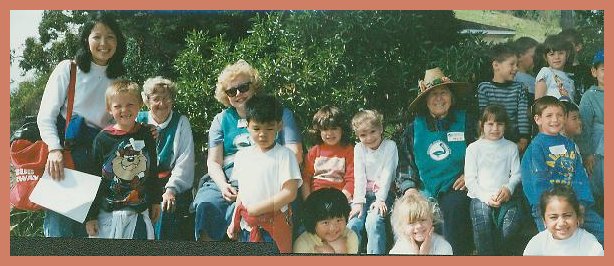 Some cute kids at the end of their outing with Mrs T, two guides, and the teacher.
Some cute kids at the end of their outing with Mrs T, two guides, and the teacher. 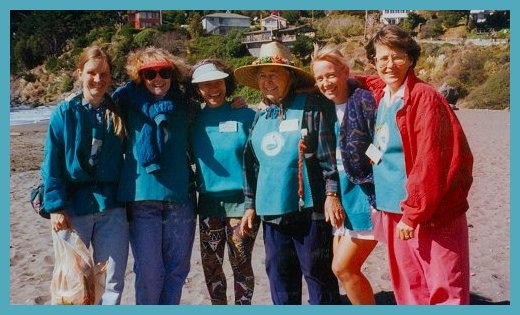 Mrs T, Wildcare guides-- at Muir Beach one day after the childen had gone.
Mrs T, Wildcare guides-- at Muir Beach one day after the childen had gone. The nature guides are all volunteers; and during these years, there were also two paid full-time staff members who handled all the scheduling, organization, and training of new guides, not to mention also doing classes with children themselves. The program shown here is run in various locations around the San Rafael area, where the guides meet a teacher and her/his class, along with several parents, at a pre-arranged time. The event takes about 2-2 1/2 hours.
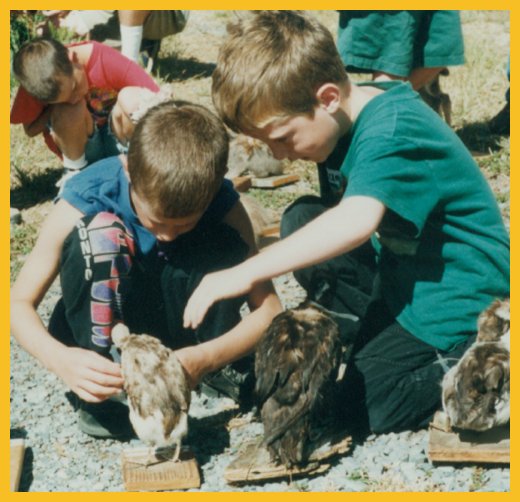 Two boys intent on the stuffed animals.
Two boys intent on the stuffed animals. The guides arrive before the children and get the animals out of the van. Then, when they first arrive, the children have a few minutes to look at the animals and touch them, and to ask questions.
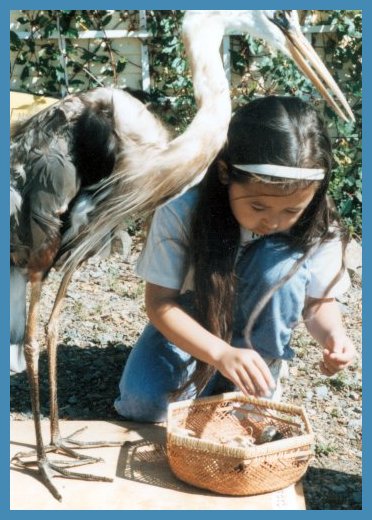 This girl is looking at the small animals in the basket that are examples of what the Great Blue Heron eats.
This girl is looking at the small animals in the basket that are examples of what the Great Blue Heron eats.
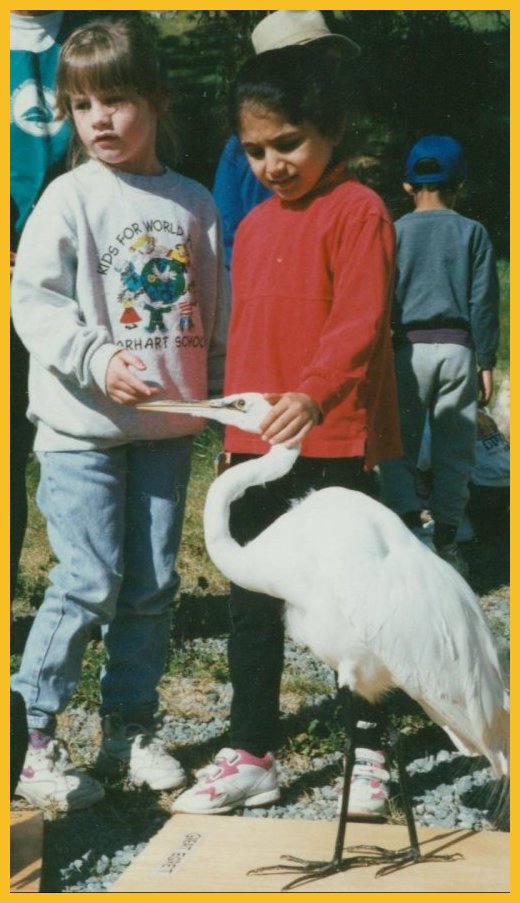 These lucky girls get to stroke an egret, one of the kids' favorite animals.
These lucky girls get to stroke an egret, one of the kids' favorite animals.
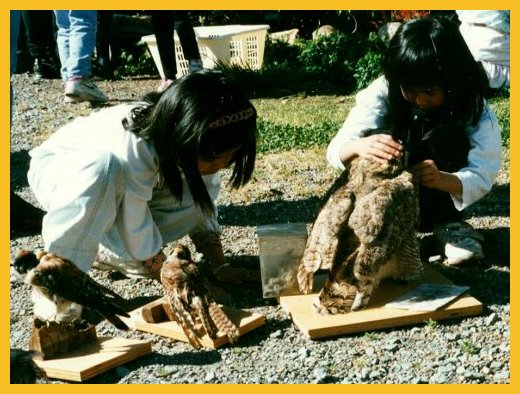 Two girls with small birds.
Two girls with small birds.
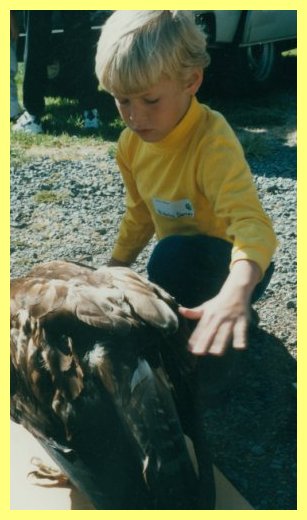
Boy says hello to an eagle.
 Children intent on Mrs T's words.
Children intent on Mrs T's words.
Then comes "circle time", during which the guides teach about the animals, using motions, sounds, and an interactive style.
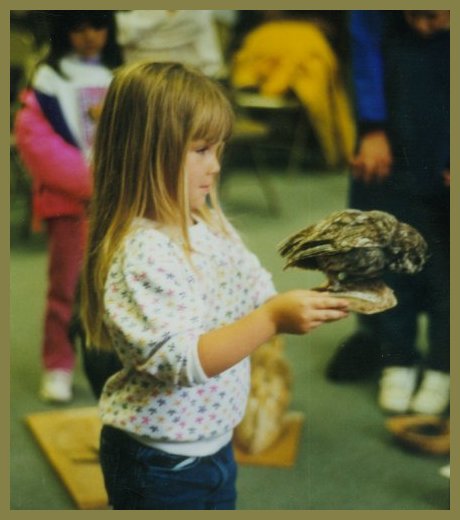 A second grader proudly carries a bird around during "circle time" for the other children to examine.
A second grader proudly carries a bird around during "circle time" for the other children to examine. 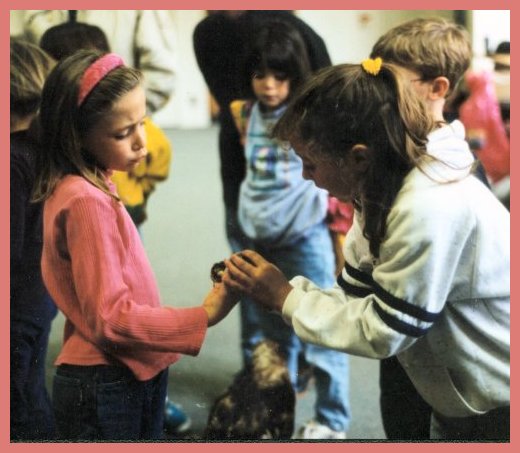 The girls are looking at a stuffed mouse.
The girls are looking at a stuffed mouse. The stuffed animals are all common local native species. They are all animals who met with accidents and are obtained through local people who pick up any freshly-dead animals they encounter on the roads, beaches, and so on.
One of the primary tenets of the program is, as Mrs T always said: "You won't destroy what you love". Nowadays, many people actually fear the outdoors, primarily because it is known to them only through the scare-dominated images of the media. Children seldom get to touch animals, and never get to touch wild ones. That is the main reason for using taxidermied animals. Even though the animals wear out fairly fast from all the loving they get from the children, it is a mainstay of the program. (And non-toxic taximdermy is a big item on the budget.)
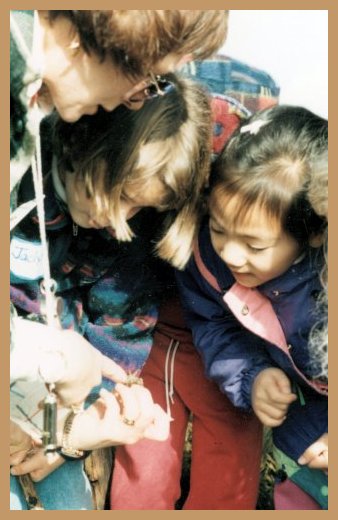 Guide showing girls an insect. They seem to be amazed - they certainly are interested!
Guide showing girls an insect. They seem to be amazed - they certainly are interested! We also encourage hands-on during the walks that follow. After circle time, the group is split into smaller groups of a few children plus one parent and one guide. Each group takes a slightly different path around the area, and the children look at plants, animals, insects, and whatever else about nature or the environment is immediately observable.
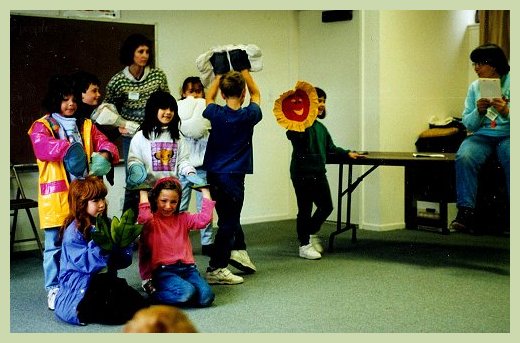 Part of a "rainy-day program". Children performing a play about where water comes from. The children on the floor are plants, the middle ones are rain drops. Some are clouds, and one is the sun.
Part of a "rainy-day program". Children performing a play about where water comes from. The children on the floor are plants, the middle ones are rain drops. Some are clouds, and one is the sun. If it rains, never mind. The guides arrange a rainy-day program, which the children love too.
Wildcare has outings for several school groups every week, as well as other programs - for example, a school visitation program, and an animal-loan program. But if you want to take your class on a trip, be sure to call early in the fall. The outings are filled up almost immediately after scheduling is opened. Have I made it clear how much I admire the Wildcare program? Thanks, Mrs T! You have made a difference in the lives of many, many people-- including mine.
By the way, Mrs T's well-deserved local renown is due not only to this work but also to her determined endeavors and successes in preventing wildlife habitat from becoming condominiums. She also wrote a book and received several awards. (See the Wildcare site https://www.wildcarebayarea.org/nature_education if you want more info.)